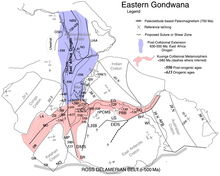Kuunga orogeny

The Kuunga orogeny (from Swahili, "to unite")[1] is an orogeny that occurred in South-east Africa during the Ediacaran and Cambrian. Composed of three separate orogenic belts — Damara, Zambesi, and Lurio — that are slightly younger than the East African orogeny, the Kuunga orogeny documents the collision between north and south Gondwana, or what is today Dronning Maud Land in Antarctica and northern Mozambique in Africa.[2]
The name was proposed in 1995 by J. G. Meert, R. van der Voo and S. Ayub.[3]
References
Notes
- ^ Meert 2003, p. 32
- ^ Grantham et al. 2013, Introduction,p. 86
- ^ Meert, J. G.; van der Voo, R.; Ayub, S. (1995). "Paleomagnetic investigation of the Neoproterozoic Gagwe lavas and Mbozi complex, Tanzania and the assembly of Gondwana". Precambrian Research. 74 (4): 225–244. doi:10.1016/0301-9268(95)00012-T.
Sources
- Grantham, G. H.; Macey, P. H.; Horie, K.; Kawakami, T.; Ishikawa, M.; Satish-Kumar, M.; Tsuchiya, N.; Graser, P.; Azevedo, S. (2013). "Comparison of the metamorphic history of the Monapo Complex, northern Mozambique and Balchenfjella and Austhameren areas, Sør Rondane, Antarctica: Implications for the Kuunga Orogeny and the amalgamation of N and S. Gondwana" (PDF). Precambrian Research. 234: 85–135. doi:10.1016/j.precamres.2012.11.012. Retrieved 10 September 2017.
{{cite journal}}: Invalid|ref=harv(help) - Meert, J. G. (2003). "A synopsis of events related to the assembly of eastern Gondwana" (PDF). Tectonophysics. 362 (1): 1–40. Bibcode:2003Tectp.362....1M. doi:10.1016/S0040-1951(02)00629-7.
{{cite journal}}: Invalid|ref=harv(help)
